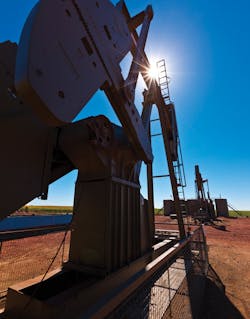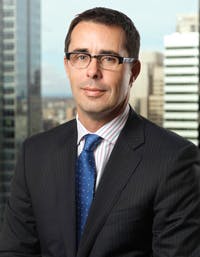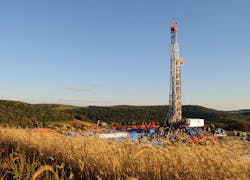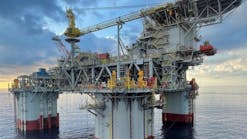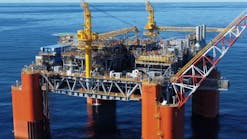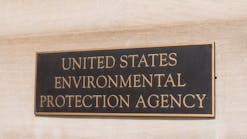Turning market challenges into Marcellus, Bakken opportunities
Enerplus operations in the Bakken. All photos courtesy of Enerplus Resources
OIL & GAS FINANCIAL JOURNAL: Thank you for taking the time to talk with me today. I understand that Gordon Kerr retired as president and CEO of Enerplus on June 30 and that you have succeeded him in those roles and also as a director of the company. Congratulations. Can you tell our readers a little about your background and how you prepared for this new position with the company?
Ian Dundas: Don, let me start by thanking Gord for all his hard work and accomplishments. Gord and the hard-working employees at Enerplus have done a remarkable job transforming Enerplus from a Canadian royalty trust into a leading North American oil and natural gas company. As for myself, I've been with Enerplus for more than 10 years. I started my career at the company in 2002 in a business development capacity and quickly expanded into a strategic planning role. This played an integral part in my success at Enerplus. allowing me to work with many Enerplus employees. Together, we transitioned through our royalty trust structure to a robust E&P company. We identified new oil and natural gas assets that provided long-term value for our shareholders, and we built a core position in the Marcellus Shale at a very attractive valuation during the height of the financial crisis of 2009.
My financial experience, combined with my brief career as an attorney prior to Enerplus, helped mold and shape my analytical and strategic thinking. And while I enjoyed law, I quickly grew to learn that my true passion was strategic development in the oil and natural gas space.
OGFJ: You were instrumental in repositioning the company's portfolio, including the acquisition of about $1.5 billion in assets and the divestment of nearly $1 billion in non-core assets. Can you tell us a little more about what you bought and what you sold and explain the strategy behind your decisions?
DUNDAS: The A&D market has always played a big role at Enerplus. In 2009, however, during the height of the financial crisis, it played an even bigger role as we began to refocus our business. The financial crisis of 2009, combined with the collapse in natural gas prices and the change in the tax regime in Canada, forced us to realign our portfolio. We quickly began to exit assets that were smaller and more conventional in nature, and we took on a more disciplined approach toward growth. We even had an oil sands project, a project that was simply a bridge too far for us operationally and financially. So we exited that play as well as other conventional plays. The process freed up capital that enabled us to enter early-stage unconventional oil and natural gas plays. Since that time, the early 2009 period, Enerplus has invested about $3 billion buying land and drilling wells. The most notable are our Bakken and Marcellus Shale positions, and to a lesser extent, our liquids-rich gas position in the Deep Basin.
OGFJ: Do you strive to maintain a certain balance between oil assets and natural gas assets? About what percentage of each do you have? With current low prices, are the dry gas assets a drag on the company's profits right now?
DUNDAS: I wouldn't say it's that simple. We have seen value in developing both oil and natural gas. Certainly, it would have been to our advantage to have focused exploitation on our oil assets during the past two years as oil prices continue to hold in and around $90 to $100. To this extent we have reallocated about two-thirds of our capital budget toward light oil development and exploration. While our position in the Bakken is extremely important to us, we also have a strategic position in the Marcellus. When we decided that we were going to invest in natural gas – albeit a smaller level in natural gas – we knew that we had to be in the highest rate of return natural gas basin. That is clearly is the Marcellus.
OGFJ: Where do you see your greatest growth opportunities? How is your capex budget allocated this year?
DUNDAS: In the past two years, the Bakken and the Marcellus have taken the lion's share of our capex, with the Bakken getting the most attention. For example, this year we'll invest around $300 million in the Bakken and $80 million in the Marcellus. By way of comparison, last year we invested about $160 million in the Marcellus, so you're seeing those spending levels fall considerably. Part of that can be attributed to lower activity in the Marcellus, but we're also moving toward more of a manufacturing process in the Marcellus, which is helping us become more efficient and productive in the play, and this requires less capital.
From a growth perspective, we look at our assets with a focus on four core areas — the Bakken and the Marcellus in the US, which have locked in growth in front of them for years to come, and two projects in in Canada. One of the Canadian projects, an oil-waterflood/enhanced oil recovery project is a steady business. It's lower growth, but generates a lot of free cash flow, which is rather unique in the oil and gas business. So we really like that part of the portfolio. The other Canadian core area represents significant growth for Enerplus. We a have a series of early-stage projects in the Deep Basin in the Duvernay, the Montney, and the Wilrich plays. They are all in the early stage of development, and we have different levels of understanding in each play.
One play that's getting a lot of attention in Canada is the Wilrich. It's a prolific gas play that we've put appraisal capital into that during the last year and it's now development ready. So that's the next near-term growth catalyst for Enerplus. Then looking into the future, we have a significant resource in the Duvernay and the Motney. So we're now trying to decide which one makes the most sense to move forward on. Delineation drilling will be an important element in determining which to move forward on, and we'll keep the investment community updated on the status of each.
OGFJ: How hard did the global economic recession hit Enerplus? Have you made a full recovery? I understand that your first quarter results were very strong.
DUNDAS: We were not hit as hard as many companies in our sector. We maintained a strong balance sheet going in to the crisis. And the strength of our balance sheet provided us great opportunities that other companies were not able to execute on. For example, during the depth of the financial crisis in 2009, we did a $400 million deal that got us into the Marcellus at a very attractive valuation. More important, however, were not the challenges in the financial markets, but rather the challenges in the natural gas market. These industry-wide challenges created opportunities for Enerplus that helped us build a more robust portfolio of properties at attractive valuations. Moreover, the supply and demand economics taking place today in North America hold great promise for the long-term demand in natural gas and the American economy. The recent rebound in natural gas prices, combined with our oil portfolio, is generating strong returns for Enerplus shareholders.
OGFJ: Enerplus has made the transition from a royalty trust (income fund) to an E&P company. You were present and involved for much of this time. Was this a difficult process? Can you give us an overview of what this entailed?
DUNDAS: We started in 1986. I joined in 2002. In 2002 we were part way through that transition. We had gone from a royalty trust that was a non-active organization to an active development program that was relatively low risk. If you superimpose the macro changes that took place over that time, it's quite dramatic. The portfolio changes were central to our transition to a successful E&P company. And on the top of that, we had to re-staff with more technical engineers and geoscientists who more clearly understood how to develop and exploit these plays as we took on a new form as a traditional E&P company. In the past four years, we've changed out about half of our technical staff. It caused us to change our dividend policy and our capital allocation policy. The sustainability of our business has entirely transformed into a new more dynamic model. Four years ago, we focused on growth through acquisitions. Today, it's all about the growth through the drill bit. Acquisitions will still play a role in our future, but we're not dependent on them any longer. Simply put, we're a very different company than we were four years ago.
OGFJ: It's very expensive to drill in shale formations such as the Bakken, and there are difficulties in remote areas. How do you keep your costs down?
DUNDAS: One of the most important items is the change in drilling programs and complexity. We've gone from relatively small capital events to really large, expensive wells that are deeper, bigger, and more complicated. Today's unconventional wells also require complex completion techniques. In fact, today, one half to two-thirds of the cost of drilling a well goes into completions. That wasn't the case before. Managing that task is critical. You have to be focused. The success in resource plays is a function of learning and focus. Being able to innovate, build scope and scale, and tighten all pieces of the supply chain is essential. Managing risk is critical to the equation. That was a big element of the staffing changes we implemented.
OGFJ: What one message would you like to leave our readers?
DUNDAS: Simply put, we are not the same company we were a few years ago. It's a great time to look at Enerplus. We are deeply advanced in our transition. We are far more focused than we once were. The market hasn't fully embraced that yet, and that provides an opportunity for investors not currently in the stock.
OGFJ: Thanks for taking the time to talk with us today.
